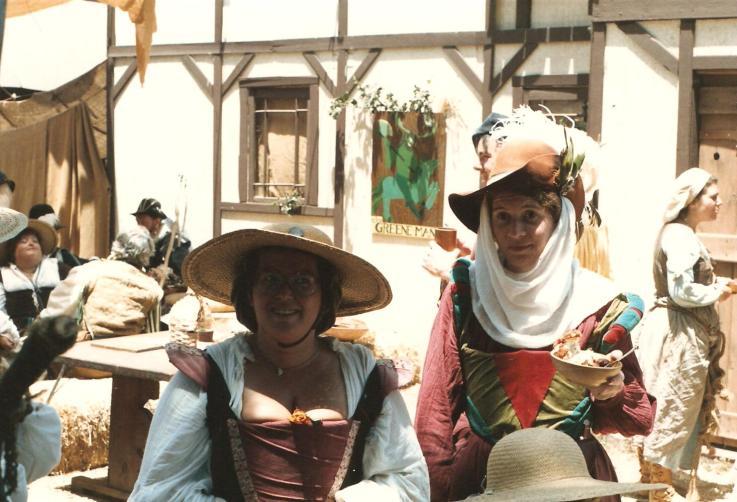Kage Baker wrote pretty continually from the time she was 9 years old. Stories, at first; then they got longer and longer, scenes changed into chapters, and adventures tended to unfold forever. Like a tesseract, or a paper puzzle with an outlet to another dimension. We tried it together finally, writing an actual, formal, beginning-to-discernible-end novel—it taught Kage a lot about planning, about outlines, and plots and what to do with all those characters running all over the place.
We wrote it together and mailed it to a major science fiction publisher, after a proper query letter produced an interested invitation. But the editor reading it died, and it went from hand to hand. It was at last returned more than 2 years later, with a nice letter saying they couldn’t figure out how to market it.
So Kage decided to write something more classical. She decided on Time Travel because it interested her more than rockets and aliens. Over breakfast one morning, reading about yet another animal presumed to be extinct but found inexplicably flourishing somewhere, Kage suddenly invented The Company: Dr. Zeus, who loots the past to enrich the future, and uses immortal agents to walk all its loot forward through Time.
Mendoza was a figure envisioned one evening on the side of the I-5—a woman in a broad-brimmed dark hat and a Clint Eastwood serape, looking at a huge turnip-style pocket watch and saying “Okay, as long as you get me out of here before 1906, when the quake hits San Francisco.” Then she ended up beginning her adventures in the England of Mary Tudor—because Kage was deeply embroiled in the Renaissance Pleasure Faire, and believed in the axiom Write what you know. Most of what she knew was scholarship, and pretending to be a Tudor Englishwoman, so that’s what Mendoza knew, too.
She wrote Mendoza (the original title of In the Garden of Iden) as she had always written everything so far in her life: in longhand, in black ink, on Corrasable typing paper. It was hard enough to read in the beginning, and the damned paper of the original has gotten harder to read every year since. But I did read it, every night when I got home from work—that was the process.
Kage wrote all day; I read it at night and we argued out the changes and edits. Then Kage rewrote what needed it the next day, and wrote another few hundred words on top of that. When she’d accumulated 20 or so pages, I began typing them up—on a borrowed electric typewriter, while we argued out yet another round of edits and changes. Kage read the typed version as I finished, and we sorted out yet another round of alterations. This was long before computers … It was a funny way to collaborate, but it worked.
Mendoza was the first project where Kage used an outline. That first outline was more like animation boards, having a breakdown of every scene. She wrote that on Corrasable typing paper, too, in various colored inks, and taped them side to side in a huge scroll. Eventually it was 20 feet long or so, and was tacked to the wall of our spare bedroom—it ran around 3 walls. It was written in English, Greek, Latin, and bits of painstakingly transcribed Hebrew and Sumerian. So was Mendoza.
The scholarship was enormously broad and awe-inspiring. Kage read Erasmus, Knox, Luther, the classic Fathers of the Church; she read transcriptions of the interrogations of the Spanish Inquisition. (which resemble a psychotic Monty Python script.) She read Marlowe and Shakespeare and Anabaptist poets and the habits and practices of visionary saints. She studied botany, and we tracked rare plants all over California.
She heard there was an original Matthew Bible—the one written in English before the King James Version—at UC Santa Barbara, so we drove up to visit a friend there and abuse his library privileges. We worked our way through assorted clerks until we found an unfortunate newbie student working on the Reference Desk, and flimflammed her relentlessly. We actually persuaded her to let us see and handle the Matthew Bible manuscript! She was, in fact, on point of putting the box that held it into Kage’s hands when her supervisor came back from lunch … we were escorted out of the library, and I suspect that poor kid got fired from her student job. Kage had to content herself with transcripts.
The first draft ran to more 200,00 words. While Kage worked on the first serious edit, she also began experimenting with the support research. We were already pretty far into
Elizabethan lifestyles: now it got serious. Kage wanted to understand the food. Most recreators content themselves with bread and cheese and beer, and maybe candied flower petals: Kage learned to make ballottines, the classic egg in a bird in a bigger bird in a pig in an iguana in a lamb covered with puff pastry roast … or as close as she could get to it. She learned to cook venison standing roasts decorated with faux gems carved out of beets and lemons and gummy candies. She made pikelets, and sops in wine, and creamed turnips, and boar ham with buttercream piping, and boiled puddings shaped like castle turrets in tin buckets. When she was really obsessed, she did the cooking on the fireplace hearth in the living room, where I was typing up her latest day’s editing. And we ate them. Kage was an extraordinary cook.
We ate a lot of chocolate, too.
Music mattered enormously to Kage when she wrote. You’d think this might be a book backed with Renaissance music, but not so much. Aside from Greatest Dance Hits of the 1500’s (Critic’s Choice label, as I recall), from which comes Mendoza’s favorite pavanne, the sound track for the book was … the Police. Mostly Synchronicity, played in Kage’s timehonored method: put it on, set the repeat lever to “Infinity” and let ‘er rip. That album is engraved on my DNA. Mendoza walks toward the summer storm in Spain to the sound of “Tea In The Sahara”. “Miss Gredenko” is playing when Nicholas hands her an orange. And the ever-recurring icthyosaur was born from “Walking In Your Footsteps.”
Kage wrote at home, at work, at Faire; on buses, in cars, squinting at the backs of candy wrappers in the twilight of movie theaters before the feature began. She never traveled anywhere without a pen and a pad—except for when she did, and so I never traveled without them either, just in case. We debated, argued, acted out the scenes, tried out different versions everywhere. Anywhere. I drew Joseph’s ill-fated midnight surgery on my own shoulder in Sharpie, for Kage to study.
It established the way Kage would continue to write for the rest of her career. So pervasive, prolific and successful was the system, that she started writing the Company short stories while she was still writing Mendoza. They began to pile up in reserve; so did the rejection slips. She didn’t have an agent, yet, and hadn’t quite gotten the trick of submission. But she had sure enough learned to write.

One fine day in the early 90s, la la la … the economy collapsed. We lost our jobs, our house, and Kage’s mother died. So we ran away not only TO the circus, but WITH it—we joined the staff (such as it was) of the Renaissance Pleasure Faire and ran off to live on the road and in the 16th century. And that was where Kage finally completed Mendoza—in a trailer in an oak wood in Marin County, still scribbling with felt tip pens on that accursed Corrasable typing paper.
Eventually, we ended up in Pismo Beach; she learned to work on a computer while transcribing the manuscript from my manually typed version to 5-inch floppy disk. (I still have them, in storage.) She had trouble learning to close files for awhile; I spent a lot of time in Kinko’s, resurrecting pages and pages of the book. Kage got it down to a reasonable size; she spent an afternoon at the library copying down agents’ addresses, and finally sent off queries to 3 of them.
One—Virginia Kidd—said yes. Kage mailed it off, the whole whacking manuscript (NOT on Corrasable paper this time!), and we waited. A few weeks later, a package was lying on our front stoop when we came home from work. Kage was about to throw it in Pismo Creek in despair, when I saw that on the front was written NOT A REJECTION …
And that is how Kage wrote the beginning. Within a year, she had 3 stories in print, and Mendoza had been retitled In The Garden of Iden. Kage Baker was in flight. Tada!
Kathleen Bartholomew is the sister of the late Kage Baker, and pretty much her life-long collaborator. She has a background in history, historical recreation, and anthropology; plus (old but devout) degrees in English and biology. Having thus far failed to die, she is continuing Kage’s work into the 21st Century. Her blog about Kage and writing can be found at https://doctorzeus.co/. She lives in Los Angeles with another sister and her family, a parrot, a Corgi and 2 cats.










